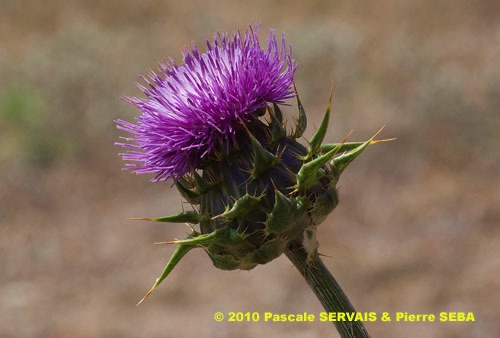
Silybum marianum (L.) Gaertn.
Fam. : Asteraceae
© Pascale SERVAIS & Pierre SEBA, 2019. Tilo Botanica: Flore de Tilos et du Dodécanèse / Flora of Tilos and of the Dodecanese
English translation by Brenda Bradbury, Howard Bradbury and Stéphane Léonard
Plante herbacée, hermaphrodite, à tiges cannelées, ramifiées, robustes, érigées, poilues.
Feuilles en rosette à la base et alternes, glabres ou à poils blancs courts, à bords épineux et ondulés, marbrées de blanc, les inférieures divisées pennatiséquées, presque glabres, pétiolées, les caulinaires plus petites, divisées pennatifides, sessiles, embrassant la tige par 2 oreillettes arrondies.
Fleurs mauves, lilas ou pourpres, réunies en capitules solitaires de 25 à 50 mm de diamètre, à fleurons tous tubulés. Bractées extérieures de l’involucre garnies d’épines sur les bords et terminées par une épine très forte de 20 à 60 mm de long, formant un angle droit avec la base de la bractée. Ovaire infère.
Fruits, akènes noir brillant, de 6 à 8 mm de long, à longue aigrette de poils blancs.
___________________________
Plant herbaceous, hermaphrodite. Stems grooved, branched, robust, erect, hairy.
Leaves in a rosette at the base and alternate, glabrous or with short white hairs, with spiny and wavy boards, marbled white, the lower ones dissected pinnatisect, almost glabrous, petiolate, the stem-leaves smaller, dissected pinnatifid, sessile, clasping the stem by 2 rounded auricles.
Flowers mauve, lilac or purple, joined together in solitary capitula from 25 to 50 mm in diameter, with only disk-florets. External bracts of the involucre provided with thorns on the edges and finished by a very strong thorn from 20 to 60 mm long, forming a right angle with the base of the bract. Ovary inferior.
Fruits, black shining achenes from 6 to 8 mm long, with a long pappus of white hairs.
Descripteurs / Identifying features
1
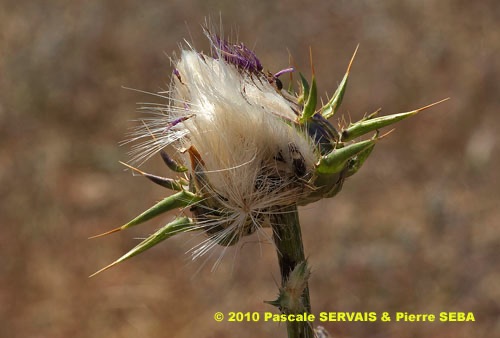
2
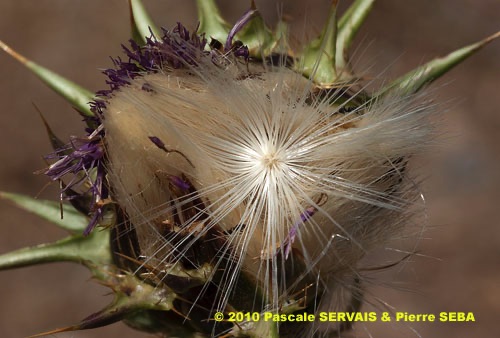
3
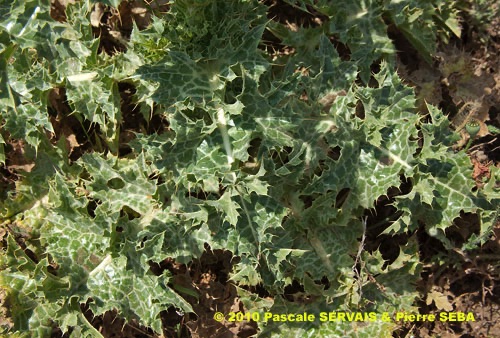
4
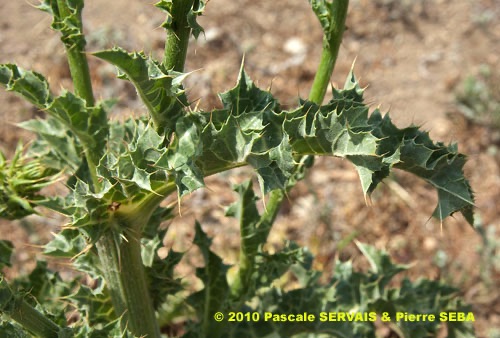
5
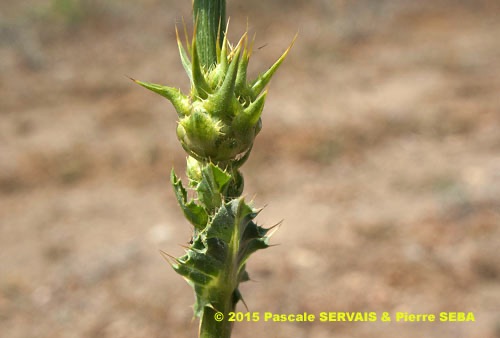
6

7
Étymologie / Etymology :
Silybum : emprunt du latin silybum, -i (nom) = le chardon, nom donné à
la plante par Pline, naturaliste latin mort en 79 apr. J.-C., forme
latinisée du grec ancien σίλυβον, -ου (nom) = le chardon, nom donné
à la plante par Dioscoride, médecin et botaniste grec mort
en 90 apr. J.-C.
Marianum : emprunt du latin médiéval marianus, -a, -um (adj.)
= de la Vierge Marie, en référence à la légende qui attribue les taches
blanches caractéristiques des feuilles au lait de la Vierge qui allaitait
Jésus pendant leur fuite en Égypte.
Silybum : borrowed from Latin silybum, -i (noun) = thistle, name given to
the plant by Plinius, Latin naturalist died in 79 AD, Latinized form of
the Classical Greek σίλυβον, -ου (noun) = thistle, name given to the
plant by Dioscorides, Greek doctor and botanist died in 90 AD.
Marianum : borrowed from medieval Latin marianus, -a, -um (adj)
= of the Virgin Mary, referring to the legend which attributes the
characteristic white spots of the leaves to the milk of the Virgin
breast-feeding Jesus during their escape in Egypt.
Synonymes / Synonyms :
Carduus lactifolius Stokes
Carduus mariae Crantz
Carduus marianus L.
Carduus versicolor Salisb.
Carthamus maculatus (Scop.) Lam.
Cirsium maculatum Scop.
Mariacantha maculosa Bubani
Mariana lactea Hill
Mariana maculata Samp.
Silybum maculatum Moench
Silybum mariae (Crantz) Gray
Silybum marianum var. longispinum Lamotte
Noms vernaculaires / Common names :
Noms français / French names :
Artichaut sauvage — Chardon argenté — Chardon de Notre-Dame —
Chardon marbré — Chardon-Marie — Épine blanche —
Lait de Notre-Dame — Silybe de Marie.
Noms grecs / Greek names :
Αγκάβανος — Αγκάβατος — Αγκάθι — Γαϊδουράγκαθα —
Γαϊδουράγκαθο — Κουφάγκαθο — Κουφολάχανο — Ραδείκι —
Σίλυβο το μαριανό — Σύλυβον.
Noms anglais / English names :
Blessed milk thistle — Holy thistle — Lady’s thistle —
Milk thistle — Variegated thistle.
Noms allemands / German names :
Echte Mariendistel — Mariendistel.
Noms espagnols / Spanish names :
Cardo asnal — Cardo borriqueiro — Cardo de asno —
Cardo de María — Cardo lechero — Cardo lechoso — Cardo mariano.
Noms italiens / Italian names :
Cardo di Santa Maria — Cardo lattario — Cardo mariano.
Habitat :
Forêts - Cultures - Prairies - Lieux incultes - Chemins.
Forests - Cultivated places - Meadows - Waste ground - Waysides.
Île / Island :
Tilos.
Hauteur / Height range :
De 30 cm à 1,50 m.
From 30 cm to 1.50 m.
Floraison / Flowering time :
De mars à juin.
From March to June.
Groupe / Classification :
Dicotylédones.
Dicotyledons.
Pérennité / Lifespan :
Bisannuelle.
Biennial.
Description :
Photo 1 :
Localisation / Location : Tilos, Megalochorio, Environs
Date : 29/04/2010
GPS : Lat. 36,45374° N / Long. 27,33604° E / Alt. 18 m
Type : Photographie numérique / Digital Photograph (10 mégapixels)
Photo 2 :
Localisation / Location : Tilos, Megalochorio, Environs
Date : 29/04/2010
GPS : Lat. 36,45374° N / Long. 27,33604° E / Alt. 18 m
Type : Photographie numérique / Digital Photograph (10 mégapixels)
Photo 3 :
Localisation / Location : Tilos, Megalochorio, Environs
Date : 29/04/2010
GPS : Lat. 36,45374° N / Long. 27,33604° E / Alt. 18 m
Type : Photographie numérique / Digital Photograph (10 mégapixels)
Photo 4 :
Localisation / Location : Tilos, Megalochorio, Environs
Date : 29/04/2010
GPS : Lat. 36,45374° N / Long. 27,33604° E / Alt. 18 m
Type : Photographie numérique / Digital Photograph (10 mégapixels)
Photo 5 :
Localisation / Location : Tilos, Megalochorio, Environs
Date : 29/04/2010
GPS : Lat. 36,45374° N / Long. 27,33604° E / Alt. 18 m
Type : Photographie numérique / Digital Photograph (10 mégapixels)
Photo 6 :
Localisation / Location : Tilos, Megalochorio, Environs
Date : 29/04/2010
GPS : Lat. 36,45374° N / Long. 27,33604° E / Alt. 18 m
Type : Photographie numérique / Digital Photograph (10 mégapixels)
Photo 7 :
Localisation / Location : Tilos, Megalochorio, Environs
Date : 29/04/2010
GPS : Lat. 36,45374° N / Long. 27,33604° E / Alt. 18 m
Type : Photographie numérique / Digital Photograph (10 mégapixels)

Google Maps
Google Maps
Google Maps
Google Maps
Google Maps
Google Maps
Google Maps